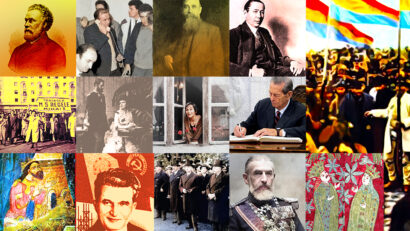Gheorghe Gheorghiu Dej and Stalinism in Romania
Gheorghe Gheorghiu Dej, Romanias first communist leader and one of the masterminds of the process of Sovietisation that started in 1945 under the control of the Red Army, died in 1965.

România Internațional, 21.09.2015, 11:56
Gheorghe Gheorghiu Dej, Romania’s first communist leader and one of the masterminds of the process of Sovietisation that started in 1945 under the control of the Red Army, died in 1965. He had been the pioneer of a new type of politics, the single, totalitarian, communist party politics. Historians view Dej as one of the executioners of Romanian democracy, a Comintern agent in the interwar years, who reached top-level positions at the end of WW2.
Gheorghe Gheorghiu Dej was born in 1901 into a family of workers, and married a working class girl as well. He worked as an electrician at the CFR Grivita works. At the age of 29 he joined the communist party, and between 1933 and 1944 he was jailed for his role in the 1933 strike at the Grivita works. Just ahead of Romania’s switching sides in the war, on August 23, 1944, Dej was released from prison and became the leader of the Romanian communist party. While in detention, in the 1940s, he shared the cell with Nicolae Ceausescu, the one who took over power after Dej died.
Stefan Barlea met both these communist leaders, Dej and Ceausescu, and took advantage of these friendships. Interviewed in 2002 by Radio Romania’s Oral History Centre, Barlea admitted that the leadership type embodied by both Dej and Ceausescu could not have been possible in a different political system:
“The system was built on the two leaders of the party and of the state during communism, Dej and Ceausescu. I believe that if it hadn’t been them, if it had been other people, better or worse than these two, the fundamental features of the system would have been the same. If you read the history of the 20th Century, you see that similar things happened in a lot of other countries. The mastermind of the economic, social and political construction in Romania was Gheorghe Gheorghiu Dej. And he created Ceausescu as well. Towards the end of his life, Dej probably felt he had to sweeten people’s lives a little, to correct a few mistakes that had been made in the past, with or without foreign influences, so he must have died a little more at peace knowing that there were no more political prisoners in Romania and that there was some economic development. In my opinion, as far as politics was concerned, Dej was certain that the Party would find the best solution to carry on his work after he was gone. This is probably why, on his deathbed, he did not nominate anyone in particular to take his place. This is apparently a common feature of all dictators, because as far as I know Stalin did the same, and so did Lenin and Mao.”
Dej was a devious and ruthless political leader, who did not hesitate to murder his opponents. Some claim that the death of the communist leader Stefan Foris in the 1940s was Dej’s doing. The death of Lucretiu Patrascanu, a known opponent of Dej, was without doubt planned by the latter, and so was the ousting of a competing group within the Communist Party, headed by Ana Pauker. Gheorghe Gheorghiu Dej’s name is tied both to the Sovietisation of Romania and to the Romanian communists’ attempt to escape the tight control of the USSR in the early 1960s. Rumors had it that Dej was subject to radiation poisoning during a meeting in Moscow, as punishment for his attempt to take a distance from the USSR. Stefan Barlea:
“We felt that Gheorghiu Dej was deeply involved in the economic affairs of the country. Not only that, but in 1945-1946 he held various top positions in important ministries. He was the senior vice-president of the government, and he chaired the committees for economic stability and economic reconstruction, and step by step he brought into the Cabinet a lot of members of the Party’s political bureau. He had a double control over the government, and at an important stage, between 1952 and 1955, he headed the government. At that time three key ministers resigned from the cabinet, the finance minister Vasile Luca, the foreign minister Ana Pauker and the interior minister Teohari Georgescu. This is how Gheorghiu Dej killed two birds in one stone, because he cleaned both the government and the party leadership of his opponents. He basically took over the helm of the government, nominating Petru Groza as president of the National Assembly.”
Stefan Barlea says Dej made no nominations for who should succeed him, but that Nicolae Ceausescu was his favorite.
“Everybody knew that Dej was ill, he had a bladder polyp and had undergone surgery, but they didn’t know his exact condition. Or maybe only the people closest to him did. About one month or so before he died, we had the last bureau meeting of the Central Committee of the Working Youth Union. This meeting was held in a small hall near his office, in the old building of the Central Committee. Ceausescu was extremely tired. We had drawn up a report, Trofin was senior secretary, and we started to say what we had done, as usual. Ceausescu listened for a short while, and then, in few words, he talked about the role of the youth organization and how important it was for its members to be aware that they are the party’s reserve pool. At that time we took his words to be just another speech. But right after Gheorghiu Dej died, we understood what he meant, he wanted support to become the head of the party. And all of us who worked in the youth organization knew, even before it was officially announced, that it would be Ceausescu who would replace Gheorghiu Dej. And this is how it happened.”
Gheorghe Gheorghiu Dej died on March 19, 1965 in Bucharest. Nicolae Ceausescu took his place. But 50 years ago, communist Romania only changed its leaders, not its governance style.





























